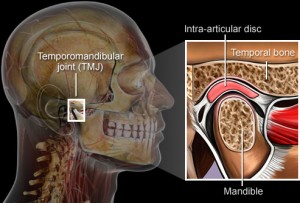Temporomandibular joint also known as jaw joint or mandibular joint is an ellipsoid variety of synovial joints, right and left joints forming a bicondylar articulation (Williams et al, 1999). The common features of synovial joints exhibited by this joint include a fibrous capsule, synovial membrane et fluid and tough adjacent ligaments etc. However the features which differentiate and make it unique in itself are: Continue reading
Tag Archives: Temporomandibular Joint
Temporomandibular joint pain Part 1
Temporomandibular joint disorder (TMJD or TMD), or TMJ syndrome, is an umbrella term covering acute or chronic inflammation of the temporomandibular joint, which connects the mandible to the skull. The disorder and resultant dysfunction can result in significant pain and impairment. Because the disorder transcends the boundaries between several health-care disciplines—in particular, dentistry and neurology—there are a variety of treatment approaches. Continue reading
Soft Night Guard Recommendations
A night guard, sometimes spelled “nightguard,” is a piece of hard or soft plastic or silicone molded (in some cases) to fit the shape of your teeth. Its purpose is to keep teeth from grinding into one another. A night guard is worn while sleeping and taken out in the morning. A night guard is also a popular treatment for TMJ, or temporomandibular joint disorder. Night guards are sometimes used in place of a nightly retainer, because a night guard also serves to keep the teeth in place as well as prevent grinding and clenching. Night guards are a well-known treatment for bruxism, otherwise known as tooth grinding and jaw clenching. Continue reading
Temporomandibular Disorder
Temporomandibular Joint Disorder
Overview of the Temporomandibular Joint
The Temporomandibular Joint is a connecting hinge mechanism between the lower jaw and the base of the skull. This joint has two components which allows it to rotate and slide. Therefore allowing our jaw to open and close. You can usually locate the joint yourself by following the tip of your nose to the side of your face. Note the diagram on the left for better understanding. Continue reading
